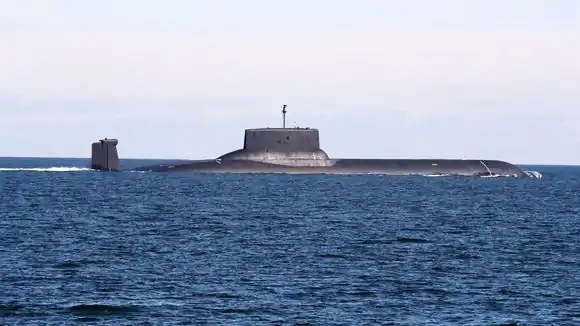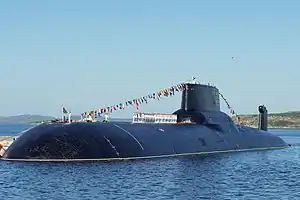Russian submarine Dmitriy Donskoi (TK-208)
Dmitriy Donskoy (TK-208; Russian: Дми́трий Донско́й ТК-208) is a Russian Navy nuclear ballistic missile submarine, designated Project 941 Akula class (NATO reporting name Typhoon). With the decommissioning and scrapping of its Typhoon sister boats (TK-202, TK-13, Simbirsk, Arkhangelsk, Severstal, and TK-210), it is the largest submarine in the world in active service.

 Dmitriy Donskoi in Kola Bay, 2018. | |
| History | |
|---|---|
| Name: | 2000 onwards: Dmitriy Donskoy |
| Namesake: | Dmitriy Donskoy |
| Builder: | Sevmash |
| Yard number: | 711 |
| Laid down: | 30 June 1976 |
| Launched: | September 1980 |
| Commissioned: | 29 December 1981 |
| In service: | 9 February 1982 |
| Status: | Active |
| General characteristics | |
| Class and type: | Typhoon-class submarine |
| Propulsion: | 2 × OK-650 reactors |
| Armament: |
|
History
Hull number TK-208 was the lead vessel of the Soviet third generation Project 941 Akula class (NATO reporting name Typhoon) of ballistic missile submarines. it was laid down at the Sevmash shipyard, Tsekh No. 55, in Severodvinsk on 30 June 1976 and launched in September 1980. At 175 metres in length, it became the world's largest submarine, a record held along with other Typhoon-class submarines.
1990–present
In 1990, it entered the dry dock in Severodvinsk for upgrades and repairs. Due to both economic and technological problems, the completion was severely postponed. In 2000, work on the submarine was intensified.
In June 2002, now serving in the Russian Navy, TK-208 finally left the Severodvinsk dry dock. After 12 years of overhaul and modifications, it had now received the name Dmitriy Donskoy, named after the Grand Duke of Moscow Dmitry Donskoy (1359–1389), the reputed founder of Moscow. The twenty launchers for the R-39 missiles it originally carried were replaced with launchers for the most advanced submarine-launched ballistic missile to date, the RSM-56 Bulava. Although it was built as a third generation submarine, the vessel is now referred to as a fourth-generation submarine due to its extensive modifications.
The first launch of a Bulava missile was carried out by Dmitriy Donskoy on 27 September 2005. The vessel was surfaced and fired the missile from a point in the White Sea. On 21 December 2005, the new missile system was tested underwater for the first time. It successfully hit a target on the Kura Test Range on the Kamchatka Peninsula.
In August 2009, Patriarch Kirill visited the submarine and met the crewmen.[1]
On 9 December 2009, Dmitriy Donskoy launched a Bulava missile. The third stage of the missile failed, and it was visible in Norway making a glowing spiral in the sky.[2]
On 7 October 2010, the submarine launched another Bulava ballistic missile from the White Sea. Targets at the Kura Test Range in the Russian Far East were successfully hit.[3]
Future
Dmitriy Donskoy and the rest of the Typhoons are to be replaced by the Russian fourth-generation submarine class, the Borei class. In 2021 it was reported that the submarine would remain in service until at least 2026.[4]
References
- Патриарх побывал на подводном ракетоносце [The patriarch has visited on an underwater missile carrier] (in Russian). fontanka.ru. 2009-08-22. Archived from the original on 2009-08-25. Retrieved 2009-08-24.
- Doug Gross (2009-12-10). "Rocket, not Santa, blamed for Norway spiral". CNN. Archived from the original on 2009-12-13. Retrieved 2009-12-10.
- "Russia's Bulava missile hits target in test". RIA Novosti. 2010-10-07. Archived from the original on 2012-10-19.
- https://tass.com/defense/1244995
- Northern Fleet section of the Bellona Foundation's website